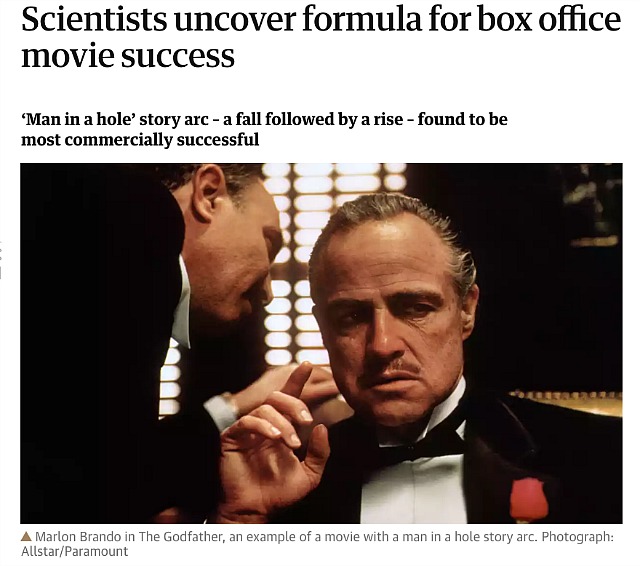This morning I read a week-old Guardian piece about the most successful movie formula — i.e., “man in a hole.” Part of the article reads like an Onion satire, but the author, Mark Brown, is dealing straight cards.
Ignore the lede and consider the second sentence: “After analyzing data from 6,147 movie scripts and filtering it through a series of algorithms, a team of UK scientists has identified the emotional arc that makes the most money, called the ‘man in a hole’ arc.”
This sounds reasonable and most likely accurate. Stories about characters gradually pulling themselves out of a bad situation (Tender Mercies, 12 Years A Slave, Birdman, Gladiator, Places in the Heart, Ordinary People, Warren Beatty and Buck Henry‘s Heaven Can Wait, Slumdog Millionaire, The Verdict, Zero Dark Thirty) always deliver a measure of comfort if not a balm to the soul.

The howler arrives in the third sentence: “[This discovery] could be game-changing for both film producers and audiences, said Ganna Pogrebna, a professor of behavioral economics and data science at the University of Birmingham, who led the research team. ‘We know that when we talk about movie production it is a small group of people that make decisions for the viewers. We were essentially trying to listen to the viewer, to see what they actually want.”
Brown explains that the Birmingham scientists have “categorized movies according to six emotional profiles or clusters, which were previously applied to novels.
“These are (1) rags to riches — an ongoing emotional rise as seen in films such as The Shawshank Redemption; (2) riches to rags — an ongoing emotional fall; (3) Man in a hole; (4) Icarus – a rise followed by a fall (On the Waterfront); (5) Cinderella — a rise followed by a fall followed by a rise (Babe); and (6) Oedipus, a fall followed by a rise followed by a fall (All About My Mother).”
Pogbrena believes that “riches to rags movies could be financially successful if they’re epic and made with a huge budget, such as Christopher Nolan’s Batman movies.” He’s also concluded that “Icarus films are most successful with a low budget, and that Oedipus films do not do well at awards ceremonies.”
The research data claims that The Godfather is a “man in a hole” movie, or one in which the lead character (i.e., Michael Corleone) starts out more or less happy or at least content, falls into a pit of danger and misfortune and then gradually climbs out of it. In fact Francis Coppola‘s 1972 film has two lead characters — Marlon Brando‘s Vito Corleone + Al Pacino‘s heir apparent — who experience this fate.
I find Pacino/Corleone’s arc in The Godfather, Part II much more interesting — powerful man in a spiritual hole that he can’t get out of, digs himself in deeper, confesses to his mother that he’s trapped, doubles down on his demonic paranoid nature (tosses out wife, kills brother) and ends up in a colder, lonelier place than when he started.
Brando’s Terry Malloy isn’t an Icarus figure — he’s a standard “man in a hole” guy (complicit in murder, brusque and guilt-ridden, falls in love, comes clean to girlfriend, defies satanic gangster figure, restores his soul).
Michael Ritchie and Robert Redford‘s The Candidate is a twisty rags-to-riches story — progressive-activist lawyer who’s a big fish in a small pond (Redford’s Bill McKay) runs for U.S. Senator from California, gets roped into the psychological gamesmanship of a political campaign, cheats on wife, ends up defeating conservative, white-haired Republican opponent but is totally lost at sea at the finish — a decidedly less happy, less secure guy than he was at the beginning.
None of the Best Picture winners of the 1990s are “man in a hole” stories, or at least not by my sights.









